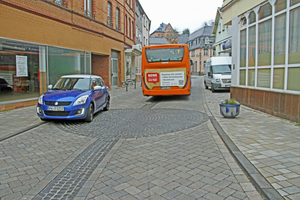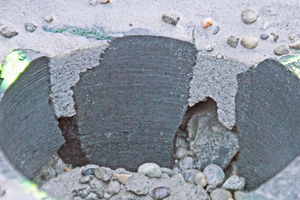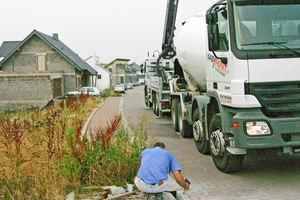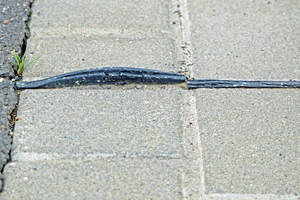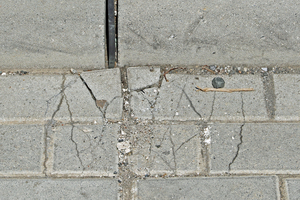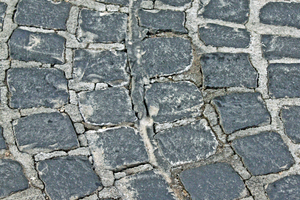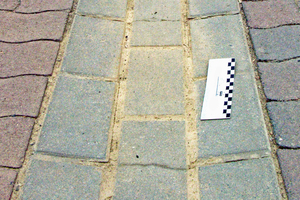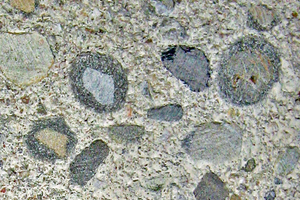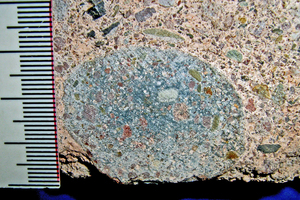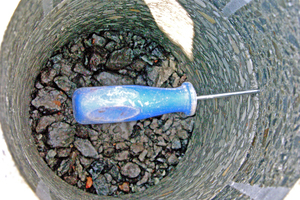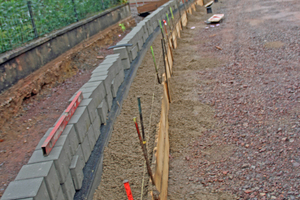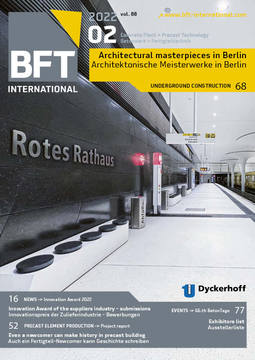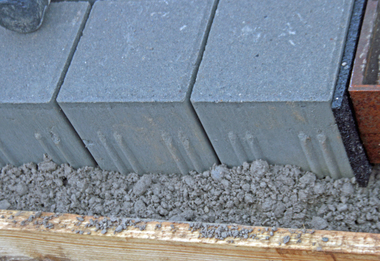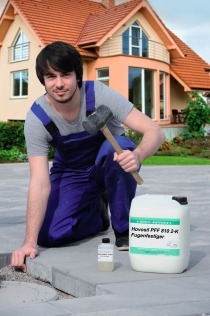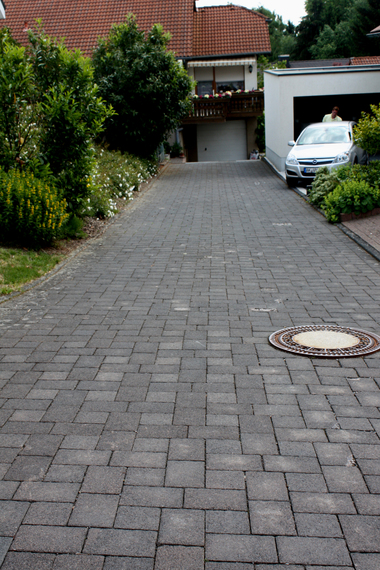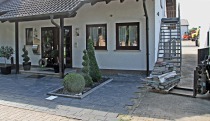Guidance on the design and installation of paved concrete gutters (Part 1)
Gutters are components whose construction requires both designers and contractors to possess the necessary expertise and many years of experience. This article is the first of a series of two contributions setting out to describe the most significant errors and shortcomings in the design and construction of paved concrete gutters in order to minimize them. Read Part 1 here.
1 Design basics
Gutters are components whose construction requires designers and contractors to possess the necessary expertise and many years of experience. This is why utmost care must be taken to ensure that appropriate construction materials and methods are selected with the aim of installing durable, serviceable drainage gutters. This article sets out to describe the most significant errors and shortcomings in the design and construction of concrete gutters in order to mitigate the risk of damage to them.
1.1 Loads acting on gutters
It is not uncommon for designers to underestimate the traffic load acting on drainage gutters. More often than not, traffic areas are designed in which a couple of negative factors add up, which is why damage to such gutters is virtually inevitable. The example shown in Fig. 1 depicts a heavily loaded gutter in the center of a narrow street with bus traffic that was designed and constructed using small, high-density quarry stone blocks.
Combined with inappropriate mortar placement in the joints, these areas exhibited major damage in some cases, as shown in Fig. 2. Such damage usually first affects the jointing mortar (cracking) and subsequently the entire gutter (loosening and breaking-out of the quarry stones).
Sampling revealed that there was no adequate bond between the very dense quarry stones and the mortar. Installation of high-density quarry stone blocks increases the risk of detachment of the mortar from the paving stones. Cracks between the building materials appeared particularly prominently in the edge zone of the gutter, favored by the fact that the design did not include an edge surround. The design and dimensioning of gutters must also consider significant loads that may well exceed those during the actual service life, especially in the construction phase. Fig. 3 shows a “quiet residential street” that, according to the information provided, was only rarely used by trucks for refuse collection and other purposes, in addition to the usual car traffic. During the construction phase, however, even such gutters are regularly subjected to high loads by delivery vehicles, including a ready-mixed concrete truck and a concrete pump (see Fig. 3).
1.2 Temperature-induced expansion and move
ment joints
To be able to relieve thermal stresses occurring in the gutter systems without causing damage, movement joints must be included in curb, gutter or combined curb/gutter systems that run straight and vertically through the entire bonded cross-section and ensure complete separation of adjacent surfaces. Appropriate movement joints must also be provided in the area of embedded parts and connections. Even though all codes and standards point out the problem of movement joints, the magnitude of the resulting deformation is often underestimated. For example, thermal deformation alone owing to the temperature change on the gutter surface (at assumed temperatures between -20°C and +50°C) easily triggers changes in length of approx. 0.5 to 1.0 mm/m, which can include both expansion and contraction of the gutter depending on the installation temperature.
Assuming installation of the gutter at a temperature of 10°C and summer temperatures of approximately 50°C occurring on the gutter surface, a movement joint spacing of 8 m will result in a temperature-induced expansion of the gutter structure by about 3.2 mm, which must be absorbed by the movement joints (see also Fig. 4).
For this reason, movement joints in paved gutters without drains should normally be designed with a maximum spacing of 8 m or, better still, 6 m. In addition, movement joints must be included on both sides of road gullies or embedded elements. Insufficient attention paid to the movement joint spacing and the compressibility of joint liners (see Section 1.2) will often cause significant damage to the facing of the concrete pavers laid adjacent to the movement joints, as shown in Fig. 5. More often than not, such a damage pattern will give rise to the incorrect conclusion that pavers of substandard quality were used.
In addition to the movement joint spacing, the installation temperature and the deformability of joint liners, the risk of temperature-induced cracking essentially depends on the bond strength between the foundation concrete and the paving blocks. The risk of cracking occurring at regular intervals in bonded structures thus increases
with increasing movement joint spacing
with decreasing bond strength between the foundation concrete and the paving blocks and
with increasing installation temperature.
The bonded gutter will try to expand when it heats up. If the bond strength between the blocks and the foundation concrete is insufficient, it will bulge and cause bending stresses to occur on its top side. Cracking of the gutter will occur if tensile stresses are present due to cooling of the gutter because cementitious construction materials can only absorb relatively low tensile stresses. Such stresses can only be relieved without causing damage if movement joints are designed in a sufficiently narrow spacing and in the presence of a sufficiently strong bond between the gutter stones and the base.
1.2.1 Joint liners and installation temperatures
To ensure damage-free absorption of the above-mentioned temperature-induced expansion of the gutter, permanently compressible joint liners should be used that can compensate for the deformation of the gutter system without causing damage. At the same time, however, liners must be sufficiently stiff and capable of returning to their original shape to ensure that the joint adequately supports the last row of stones before the movement joint. As these explanations show, the movement joint, despite being deformable, must additionally assume the function of a “back support” for the paving blocks to provide them with sufficient “positional stability”. If the joint liner is exceedingly susceptible to deformation, this will cause cracks to form in the cementitious joints adjacent to the movement joint (see Fig. 6). Among other factors, the damage shown above resulted from the joint liners failing to exhibit sufficient resistance to deformation so that the adjacent paving stones were displaced by the shear forces acting on them, resulting in mortar cracking and detachment. It is precisely this trade-off – the deformability required of the joint liner versus giving way too easily – that has given rise to the often controversial debate among experts over whether relatively hard (such as polyurethane or vulcanized rubber) or soft materials (such as polyolefin foam) should be used as joint liners.
Currently, experts predominantly argue that
soft liners should preferably be used for gutters subject to comparatively minor loads while
hard liners should preferably be used for gutters subject to high loads.
As this discussion shows, there is no universally applicable, “100% correct” solution with regard to the hardness or rigidity of the joint liners. Instead, a balance must always be struck between the deformability required of the joint liners so that they can absorb temperature-induced expansion and the required positional stability of the paving stones adjacent to the liner. The installation temperature of the gutter also plays a crucial role in this trade-off. The higher the temperature during the installation of the stormwater runoff gutter is, the lower the temperature-induced elongation to be absorbed by the joint liner will be so that a lower deformability of the liner will be required. However, high installation temperatures cause the gutters to contract to a larger extent during cooling, resulting in significantly greater tensile stresses in the gutter systems associated with an increased risk of cracking (see Fig. 7).
In the case of such cracks, too, occurring at regular intervals, the parties involved in the project usually put the blame on the quality of the paving stones because this is where the cracks show. In reality, however, this damage is usually more likely to be due to excessively wide joint spacing, high installation temperatures, high jointing mortar strength levels and, most importantly, a compromised bond between the gutter and the base. Another factor influencing crack propagation in the gutter is the stone size: The risk of cracking of the paving blocks increases significantly with greater stone or slab size, whereas smaller stone or slab dimensions tend to cause cracks primarily in the joints (or in the joint-block contact zone), where they are much less noticeable.
1.3 Jointing mortar
From a technical point of view, the jointing mortar should ensure proper “gluing” of the gutter paving blocks while reducing water ingress into the base as far as possible. However, this will be achievable only if the joint is completely filled with mortar and if the mortar is highly flowable. In addition, mortars must exhibit a sufficiently high freeze-thaw resistance in order to ensure long-lasting performance and to retain a certain appearance throughout the gutter’s service life. Self-mixed cement mortars usually do not have all the required properties, which is why the current standards and guidelines (M FPgeb, ATV DIN 18318 and ZTV Wegebau) make it mandatory to use materials with a corresponding proof of fitness for purpose.
In the meantime, however, the demanding freeze-thaw requirements for such mortars have resulted in ever-greater compressive strength values. From today’s point of view, this development went in the wrong direction because such high mortar compressive and tensile strength levels caused cracking of the paving stones instead of the mortar, which resulted in greater visibility of the defects. Currently applicable standards and guidelines (M FPgeb and ATV DIN 18318) thus include upper compressive strength and elastic modulus limits in order to mitigate the risk of cracking of the paving stones.
2 Installation of stormwater runoff gutters
2.1 Foundation concrete
2.1.1 Concrete delivery
To limit the associated cost, the concrete required for foundations has been produced on-site only in exceptional cases for a number of years. This is why ready-mixed concrete with a very dry consistency is used almost exclusively. Due to its very stiff consistency, however, the cement often cannot be broken down completely when mixing these materials, resulting in the cement pockets shown in Figs. 8 and 9.
Their formation results in the cement added to such concrete mixes being partially bound as “cementitious aggregates” (similar to the cement bound to recycled aggregate particles) that do not contribute to the strength development of the concrete.
2.1.2 Storage of concrete on the job site
An adequate bond between the foundation concrete and the gutter system is an essential prerequisite for installing durable and damage-free gutters. Nowadays, ready-mixed concrete is generally used for installing concrete foundations of gutter systems. The concrete is usually delivered to the job site early in the morning and cannot be processed quickly enough due to the slow work progress. It thus remains unused on the construction site for the major portion of the day and is exposed to the inclemencies of weather (rain, sun and wind). This “interim on-site storage” is usually not carried out properly because the concrete is not sufficiently protected against excessive dehydration. To prevent subsequent damage to the gutter, retarded concretes would have to be used, which are stored on-site such that the concrete does not lose the water required for the hydration process. This is why the concrete should be stored in “piles” and covered with plastic film.*
In the usual procedure, in which the concrete is either stored in piles without additional protective measures (plastic film cover ...) or even spread directly in the formwork, a sufficient bond between the foundation concrete and the paving blocks is usually not achievable because, on its surface, the concrete will dry out (“surface drying”), and no adequate bond between the gutter pavement and the foundation concrete can be established (see Fig. 10).
Fig. 11 below shows a “common” (but inappropriate) procedure in the course of constructing the gutter system. As the image reveals, on this construction site, the foundation concrete was placed in the area of the planned gutter system (in this case, even the formwork had been placed beforehand) until the ready-mixed concrete truck was completely emptied. This pouring method deprives the concrete of the water required for hydration for hours in the areas where the foundation concrete lies open for a long time, and the concrete will “die of thirst”. Foundation concrete placed in this way is highly likely to fail to establish an adequate bond to the underside of the paving blocks of the gutter across major portions of the installation area.
* Author’s note: To prevent damage, some contractors favor the use of retarded concretes. However, adding a retarding agent is useful only if the concrete is protected from dehydration during storage by appropriate post-treatment methods. Even though retarders extend the working time of the concrete, they are not able to reduce the risk of “thirsting”. Quite on the contrary, retarding the concrete actually results in the water required for hydration being chemically bound much later, which is why even larger quantities of water will be released into the environment. The risk of dehydration thus usually increases if retarded concretes are used, unless additional protective measures are implemented to prevent dehydration.
Read Part 2 in BFT International issue 3/2022.

